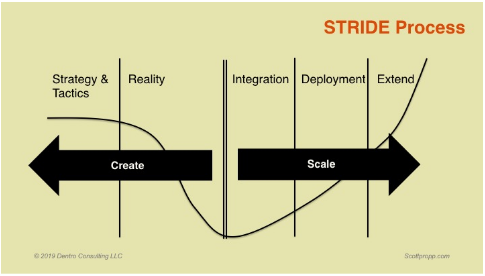
At our core, humans are pattern-creating machines. To avoid cognitive overload, we do many, many things the same way every day. We get our coffee, put our pencil down, and even walk in the same paths over and over again. We like working with people who are like us and reflect back to us what we expect in predictable ways.
Broadly speaking, businesses set themselves into two natural tribes. One is the action/optimization group I term the Ops Tribe. The second is the Creative Tribe, which is made up of those who are more oriented toward carving out a fresh vision and setting themselves toward achieving it.
We tend to find our tribe early and stick to it, as we enjoy the camaraderie and shared experience of working with like-minded team members.
However, this tribalism reduces interactions and limits the “whole brain” creativity of the team.
And COVID-19 makes it worse.
History has shown us that businesses that actively bridge these tribal tendencies with cross-functional teams will outperform during times of change and adaptation.
The High Cost of “Interaction Tax”
One thing that’s very clear, is that as of the writing of this article, we will not be rid of COVID-19 for a substantial amount of time. One unavoidable consequence of this is that underlying interaction, alignment, and decision making that used to be “made to work” through close human contact is now much harder.
COVID-19 reinforces the underlying tribalism we talked about above because we are limited to virtual interactions with audio and video of one another – and are now missing so many non-verbal and context clues.
This interaction “tax” places big strains on our global teams. This tax and these underlying forces threaten to build a flywheel that takes your team in the wrong direction.
Tribes Form Zones

The tribes described above lead to two powerful zones inside mid-sized and larger established firms:
- The “creation zone” is governed by strategy, planning, and insight. It runs on a calendar and represents the place in the firm where insightful ideas are built into the valuable intellectual property that can be commercialized.
- The “operations zone” represents the portion of the firm that takes the work of the first team and builds it into a repeatable product or service with powerful processes, people, and quality tools. This zone is governed by the clock and key metrics which allow it to be continuously monitored and optimized.
For more insight on these zones, check out this article here.
Once formed, these two zones tend towards an inward focus. They attract people with similar leadership capacities, styles, and temperaments. And once in motion inside a firm, they tend to interact primarily within the zone and require an act of significant leadership to build the bridge of value development between the zones (see articles here, here, and here.)
Lastly, every firm has a culture that leads it to excel in one zone or the other, and its deep culture playbook becomes the “software” that each executive internalizes and tends to recreate wherever they practice.
Some Recent History on the Effect of Zones
Let’s take a look at recent history for a powerful example of this effect. When Jack Welch built GE into the most productive firm on the planet, he did so by implementing a deep leadership script that was built in the “operations zone.” Meticulous planning and execution were practiced, under a powerful meritocracy. This culture continuously sorted and stacked ranked leaders, businesses, and strategies. Those businesses and leaders that didn’t make the grade were divested.
This all came to a head when it was time to build a succession plan for GE. Clearly, only one individual was going to be chosen, and that would open the rest of the “class” for recruitment by other firms. In 2001 the press was giddy that “at least 16 former underlings led publicly-traded US firms.”
Then it began to happen. Things began to change – and not in a good way. By 2003, we started to see articles like “Do They Know Jack,” noting that the performance of the firms was really mixed. By 2013, even McNerny, who had early success, was being panned for overplaying the “Six Sigma” playbook.
While the press wanted to hang the success on using the playbook, there is something more subtle and powerful going on here.
As we talked about in the last article, it’s those firms that have a balance of excellence in the zones, AND the ability to move value between them that build enduring and valuable enterprises. In each case, the post-GE exec appears to have overplayed the Operations Zone playbook, and without the balanced approach, the value was lost.
How to Build the Value Bridge
What does this mean for right now?
Before jumping into action, it’s important to get an accurate assessment of your current reality. You may be in a situation where the more you step on the gas, the more the returns for your investment may diminish. When you’ve doubled down on the wrong side of the zones, it’s spooky how seductive it is to just get another program in the door, pay the rollout fee and then wonder why the latest variant of “Lean” is not making things better.
If you have an inkling you’re there – hit pause. Do the diagnostic work in the context of the zones. Review it as a team.
Although COVID makes this work more challenging, your team and organization can avoid doubling down on the wrong side by examining the situation against a larger, more objective context.
Let me close with three points:
- Awareness of the zones, and especially the way they tend to become self-reinforcing within firms, is the starting point for more focused and effective leadership. If you are the MSE (most senior executive), when is the last time you objectively reviewed your strategic balance between the zones? How about your executive talent mix?
- How many “cross-zone” efforts are currently in the pipeline for your firm? If you find from the above that you are overinvested in a zone, you will be astounded what an investment in the “other zone” will yield.
- Cross zone work is an unnatural event and needs to be built from the ground up. This is heart surgery and needs to be approached by selecting the right project, the right team, and the right plan. If you begin without this foundation in place, the team will veer right back to its center of gravity, and lock in those diminishing returns.
Support for Completing This Work
If you would like to talk further about the specific process tools to implement a high functioning strategy that uses these insights to connect the zones, please call my direct line (847-651-1014) or use this link to set up a time for a short discussion.
Related posts you can benefit from…

